Toilet repair: features and design ideas
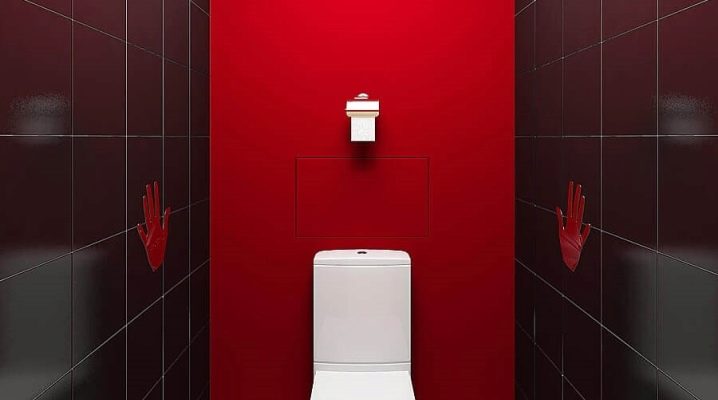
The dressing room in any house or apartment must be flawlessly executed. But not everyone knows exactly how to achieve this and what points to pay attention to. Moreover, methods for one type of building are not always suitable for others.
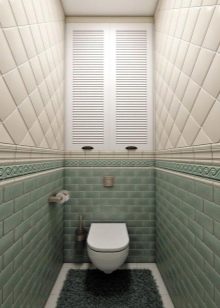
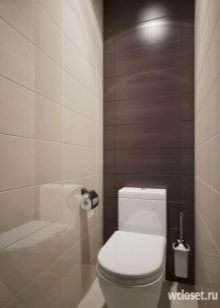
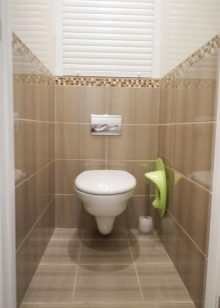
Peculiarities
Do-it-yourself toilet repair is available to almost all amateur builders. As always, you will have to take care of a well-thought-out design concept and selection of materials. Difficulties in performing work may be associated with insufficient floor space, but thanks to the simplest actions, these limitations are overcome.
It is very important not to forget for a minute about the increased hygiene standards that are characteristic of the bathroom like no other room. Before using any recommendation you like, you need to understand whether it is justified and to what result its implementation will lead.

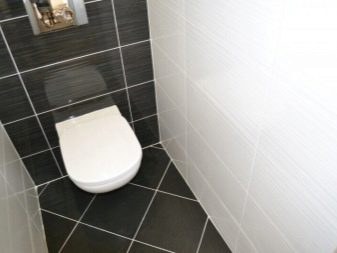
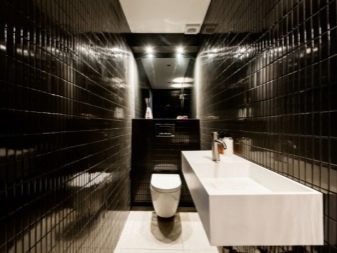

Options for different rooms
When you need to renovate a small toilet, the first step is naturally thinking over the concept. Moreover, if for a larger bathroom, mistakes in it can still be corrected at a certain stage of work, then here you will have to redo everything again, incurring additional costs. Before designing in "Brezhnevka" or in a small-sized apartment of an earlier period, its technical condition must be taken into account. No matter how carefully they once built, all structures can become unusable.
Any project in such apartments should be drawn up taking into account the most efficient use of the available space.
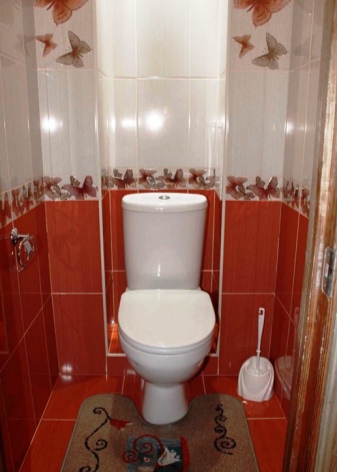
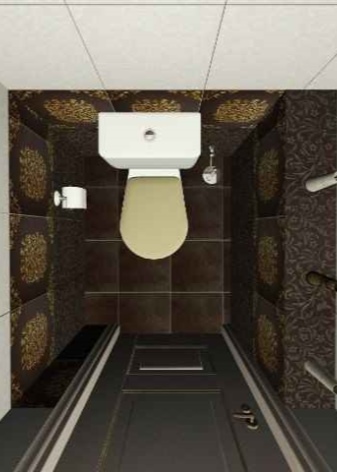
In a modern typical apartment, there is much more space for decision-making., but one thing remains unchanged: projects that require redevelopment are always worse than those that do not provide for it. It's not just about possible problems, conflicts with neighbors and with the housing inspection. Difficulties are also caused by the increased volume of work (both during dismantling and installation).
Waste disposal is a problem for the country toilet. You need to immediately decide whether it is possible to connect to the central sewage system or you will have to look for workarounds.

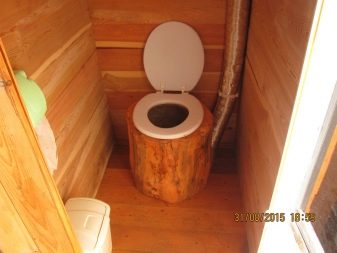
Capital
Having dealt with the peculiarities of a particular dwelling, you need to find out how much the bathroom will be subjected to global alteration. Only major repairs will help if it is decided to merge its parts together, or vice versa, to make two separate ones from one room. The cost of a high-quality overhaul is quite high, as is its duration, and only trained installers can do many work.
In new houses or after a recently made overhaul, there is no need to carry out it again. A more modest option can be considered with limited funds.
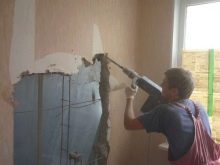
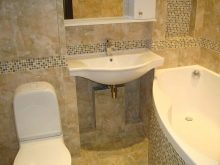
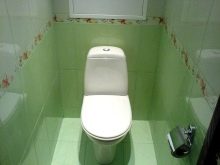
Economical
Cheap toilet redecoration will not touch pipes, walls, or meters.
This category quite fall into:
- installation and replacement of mirrors;
- replacement of faulty valves;
- installation of suspended or suspended ceilings.


When changing the toilet, this is also a budget type of repair (or part of it). But “easy, fast and cheap” does not mean less responsible. Every year, there are hundreds of cases of poor-quality cosmetic repairs in toilets, errors in which end in a flood of neighbors or serious household inconveniences.Therefore, the choice of components, decorative elements, tools, and the hiring of a team must be approached carefully.
It is unacceptable to economize on any of these components, but careful market research will allow you not to overpay for quality.

Renovation
A beautiful and pleasant-looking toilet is a cherished dream of many people. Renovation helps to bring it to life and support it in the future. It is distinguished from the usual overhaul by the presence of a specially prepared project for decorating the room. Quite often they even prepare 3D rendering using special software.
Almost always, when renovating, they totally change the infrastructure and the appearance of the finish., realize creative delights and follow the latest fashion trends. Another feature is that it is advisable to do the renovation in the whole apartment at once, and not in one toilet in isolation.

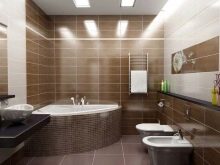
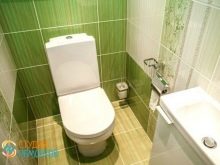
Required materials and tools
It is unlikely that it will be possible to repair the toilet properly without tools. You can dismantle old accessories using a set of screwdrivers, but this is very laborious and time-consuming. It would be much better to take a screwdriver and a set of bits for it. Concrete skirting boards are dismantled with a perforator, which also makes it easier to remove tiles and prepare holes. When working with a pipe and a toilet, the master must have a gas wrench ready.

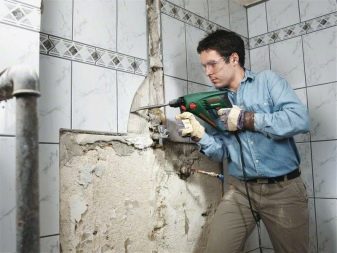
It is impossible to install new pipes, both metal and plastic, without using a welding machine.
To prepare for the application of finishing materials will help:
- roulette;
- folding meter;
- construction level;
- plumb line.


Primer, coating, putty, paint is applied with brushes and rollers. But for working with tile glue, it is advisable to take a notched trowel. A saw, a hammer, a chisel, a chisel, a file and other locksmiths, carpentry tools are also needed for standard repairs, including in other rooms. Therefore, spending on their purchase is fully justified.
It is recommended to draw up a list of the necessary tools and check with it after it is clear what work and with what materials will be performed.



For walls
Tile is deservedly considered a universal solution for decorating the walls of the toilet. But you cannot take tiles made from ordinary silicates (which have a white underside). Despite being chemically neutral, the large number of microscopic pores enhances fluid intake and retention of unpleasant odors. Fighting them with household deodorants is very expensive and also bad for your health.
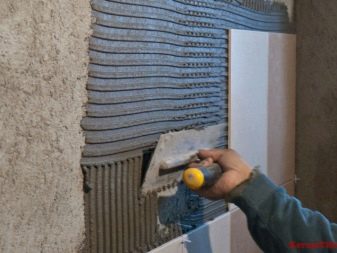
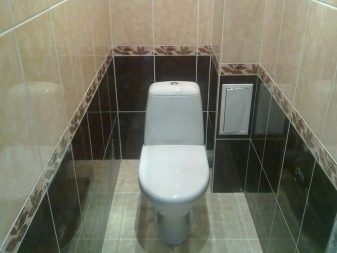
Wallpaper is considered an alternative to tiles. In the toilet, it is recommended to glue those types of them that can be cleaned and washed. With the right creativity and diligence, it will be possible to achieve a look no worse than using tiles. The problem is that even the best types of wallpaper don't last long enough. But the costs are much less, and therefore frequent replacement will not affect the wallet.
As in the previous case, the surfaces must be prepared for work.
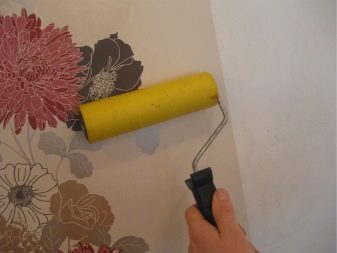
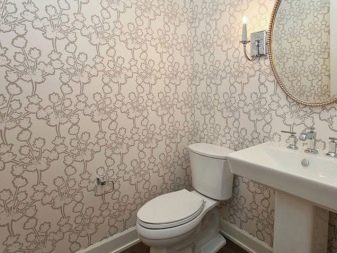
For ceiling
The standard procedure is to completely remove the old coating. But what to do next depends on the type of finish chosen. So, stretch and suspended ceilings are mounted on a simple cleaned base. If decorative plaster is used, the coatings are knocked down to the rough floor and the substrate is prepared as carefully as possible. The features of the lighting fixtures are also taken into account.
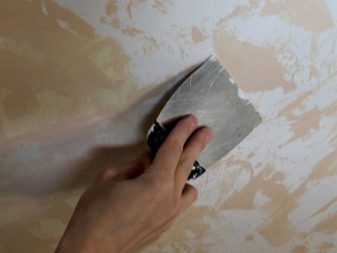
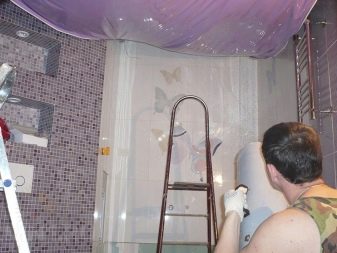
The specificity of the use of toilets and their "filling" imposes certain requirements on the materials that can be used for finishing ceilings.
First of all, these include:
- Condensation resistance.
- Tightness. When a breakthrough occurs from above, it is almost always this material that takes the first blow.
- Mechanical strength. It is not enough for the ceiling to be simply waterproof, it must also withstand the pressure of the mass of water.
- Easy access to communications hidden behind the ceiling trim.
- Elegant appearance, but without unnecessary pretentiousness and pomp.
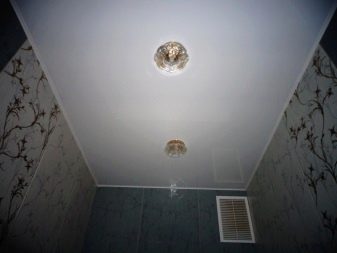
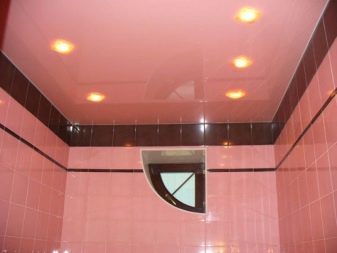
Excessively bright coverage can create inappropriate associations. Absorption of height is unacceptable, on the contrary, the color is selected in such a way as to guarantee a visual expansion of the space. Whitewashing is considered the easiest way to satisfy most of the listed requirements. It is applied in about 60 minutes, but this time is usually less. But you have to take into account that whitewashed ceilings are unstable to moisture, and the only excuse is the ease of restoring the finish.
Paint is a good alternative., especially since it is much more diverse in appearance and texture. It is recommended to use waterproof solutions - oil, silicone, latex or acrylic. Some of the water-based mixtures can also be used, but here you already need to make a careful choice.

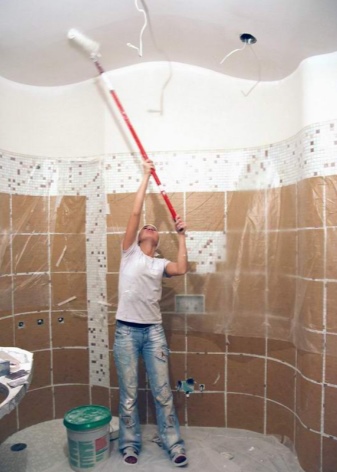
A fairly large part of consumers prefer various types of tiles, which are able not only to create a pleasant appearance, but also to compensate for minor differences in height. At the same time, the toilet does not become lower, but you will need to carefully select the color of the material and the size of the individual blocks.
False ceilings will also cover all the problems of the rough base, but they will absorb at least 3 cm in height, which is why, with all the difficulties with gluing the tiles, it is better suited for small toilets.
Cassette structures are not recommended for use in low rooms. But if the toilet is medium or large in size, there will be nothing reprehensible in this method of decoration.
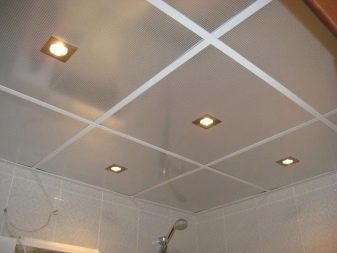
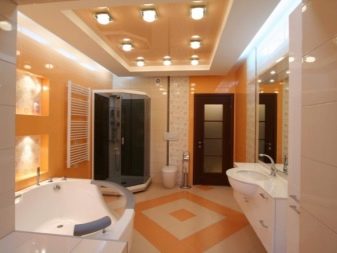
There are much more possibilities when using slatted ceilings, which are impervious to moisture and are fire safe. Lighting and wires can be easily removed inside the rails or panels, they will not spoil the appearance.
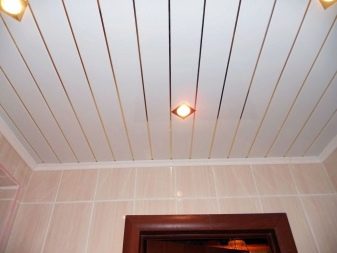
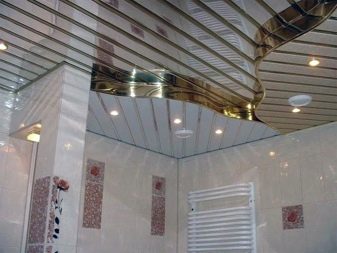
In order for the ceiling to look advantageous, like the entire room as a whole, you need to carefully select the lamps. Not every light source is suitable for all ceilings. So, for obvious reasons, highly heating structures are incompatible with suspended and tensioned canvases. The more compact the lamp, the more tightly it is pressed against the plane of the top, the more advantageous the design will be. An equally important requirement is a housing protected from moisture: in this case, we are talking about the fire and electrical safety of residents.
Spot elements provide excellent diffused light, but it is still better to put them not on the ceiling, but as accents and additional illumination of individual elements. Copper wires are best for connecting all lighting fixtures. Aluminum conducts current worse, oxidizes more actively in case of contact with air, breaks faster and easier, it is much more difficult to mount wires from it. The strobes should be sealed with a moisture-resistant filler.
Incandescent lamps should be abandoned: they consume a lot of current, and at the same time they heat the air more than they illuminate the space.
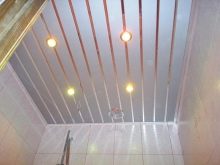

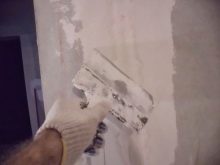
Flooring
In the toilets of a private house or apartment, the design role of the floor is no less than that of the ceiling or walls. In the same way, when preparing for its finishing, it is required to think over everything thoroughly and take into account the subtleties. Tiles made of natural stone and tiles have become widespread in the decoration of toilet floors.
Their advantages are undeniable:
- strength;
- minimal water absorption;
- abrasion resistance;
- the ability to choose a floor covering as part of a single collection (from which there will also be material for wall decoration).
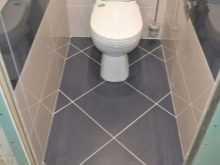

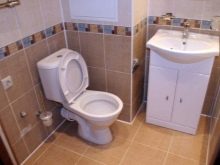
If a variety of colors is in the foreground, it is worth choosing a tile, and porcelain stoneware turns out to be the undisputed leader in hardness. All types of "stone" coatings easily tolerate the action of aggressive reagents, including household appliances.A serious disadvantage of the stone is its coldness; underfloor heating corrects the problem, but it complicates the structure, makes the work longer and more expensive. The tiles that are laid on the floor must be of 3 strength classes and higher.
Among other varieties, materials with corundum coatings and layers that reduce slip are deservedly in the first place.
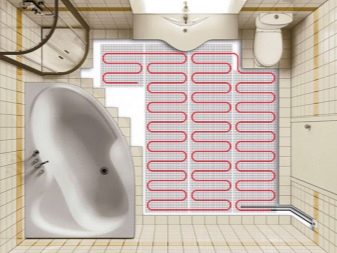
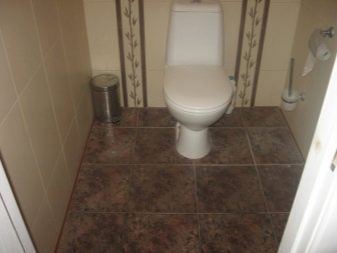
Wooden base is impractical for a toilet floor - with external aesthetics on store shelves or photographs, it will quickly swell and swell, it may rot. Moreover, even thick boards are not devoid of such shortcomings, unless they appear later. No paint and enamel will save, since they are applied only to the outside, and the rest of the planes will remain uncovered by protection. Therefore, the use of linoleum turns out to be more profitable than wood. Technologists have learned to give it a colossal external variety, which was difficult to imagine 10 years ago.
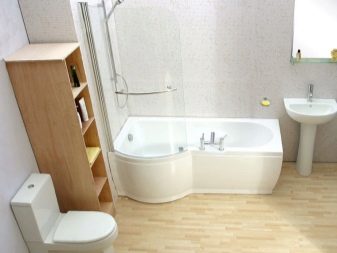
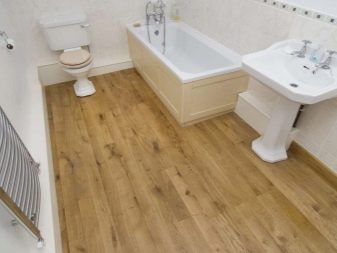
Water-resistant linoleum rolls fit well in narrow places requiring curly styling. The appearance of rot, mold fungi and microorganisms is almost impossible, it is very simple to clean the floor from dirt and moisture. But the complete tightness of the coating cannot be achieved, so it will need to be lifted from time to time, and the base must be dried and treated with disinfectants.
In terms of durability, there is no need to install semi-commercial linoleum in the toilet. Enough and the simplest everyday, even the most delicate, if only it does not slip.
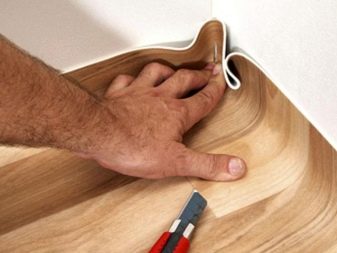
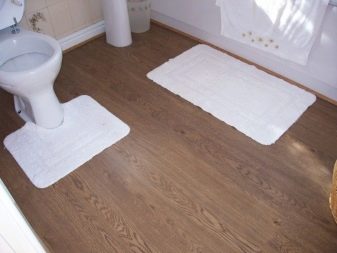
Sequence of work
It makes no difference whether a construction ace or a newbie in this field has to carry out a major overhaul. The first step is always a high-quality design of future repairs. The area of the room is thoroughly measured, since it depends on it which ideas can be realized, and which ones will remain fruitless fantasies.
Most often, especially in urban apartments of old houses, there is absolutely not enough space. In such a situation, you need to abandon the original moves and begin to fight the tightness.
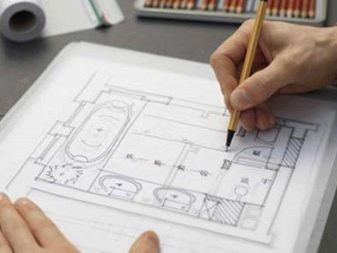

Where to begin?
Before starting the design, you should decide on the choice of equipment to be installed. In case of an acute shortage of space, they are limited to a toilet bowl. When the washroom is relatively free, you can put a washbasin, urinal or bidet in it. A minimum of 0.4 m is left between the middle of the toilet bowl and the wall, and when the sink is placed, this distance is reduced to 0.3 m. Hanging toilets do not absorb the floor space, but due to the obligatory frame, 10 cm or a little more will be taken away from the wall. In addition, the complexity of installation will require the involvement of professionals and their remuneration.
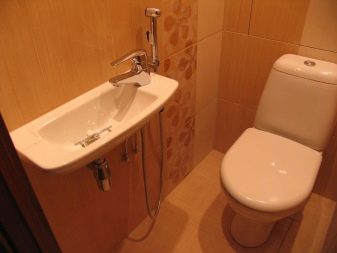
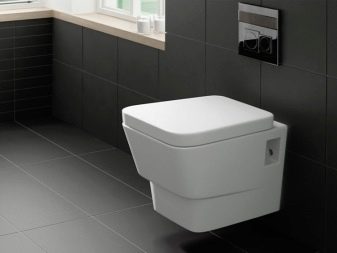
Having dealt with the "stuffing" of the toilet, it's time to think about its tone. It is better to choose between calm tones, the slightest variegation is unacceptable. Even with such a restriction, there are many quite attractive options, especially since no one forbids making local color accents. After choosing a color, you can find out the need for tools. The list of them changes depending on the planned materials.
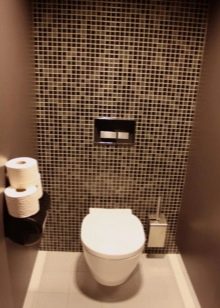
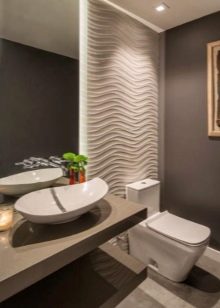
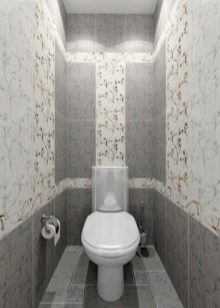
The next step is to eliminate the old plumbing and finishing materials., all unnecessary components in general. There is no particular difficulty in this, but a lot of effort and time will have to be spent. The toilet bowls of the newer versions are removed by removing the corrugation, while the older closets are fixed on a cement base. It will need to be broken. Removing the tiles is complicated by the fact that even with the wear of the outer layer, they are extremely stable.
Since work, regardless of the choice of hand or power tools, will create a lot of noise and dust, you need to prepare. The optimal period is weekday hours. At the same time, all furniture in the reach zone is covered with plastic wrap. Wallpaper is usually soaked and removed mechanically.Strong paint is not removed, with the exception of oil; for any paint and varnish material, special washes are used. The whitewash is removed with a spatula after abundant saturation with water.
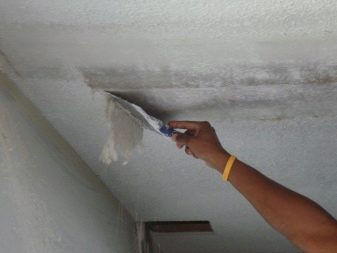
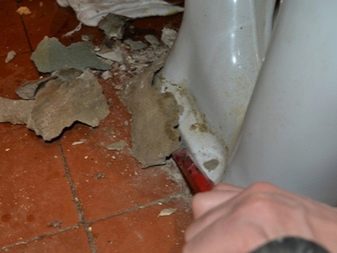
Main works
Continuing to carry out the overhaul of the toilet step by step, they are taken for the creation of improved communications. In many houses, old risers are unreliable, then they need to be replaced with new ones made of PVC. In most cases, the entire segment changes from floor to ceiling. Connections are supplied with adapters, and the modular design can be easily supplemented with parts of the required format. Pipes inside the toilet room are most often inserted into grooves; if the bidet (either stand-alone or integrated in the toilet) is not used, replacement can usually be dispensed with.
The wiring is hidden in the grooves, and the sewer pipes are in a specially designated box. If it is decided to repair the walls using plasterboard sheets, the perimeter of the rough walls is covered with a profile attached to dowels with a diameter of 6 mm. When fixing the frame, the main profiles are used, stiffeners are also used, spaced in increments of 0.4-0.5 m. After that, it is required to fix the moisture-resistant gypsum board, previously cut into fragments of the required diameter. Fixation is done using special screws.
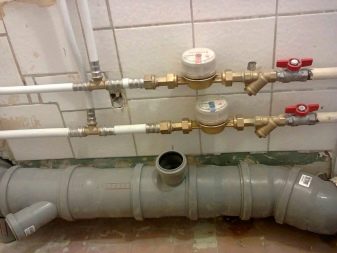
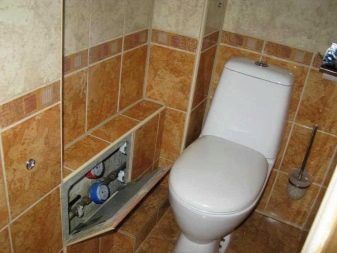
When preparing the sheets, you need to make an opening in them for the subsequent installation of the inspection door, then it will be possible to monitor the state of equipment and the numbers on the meter display. Then you need to make the flooring. Ceramic tiles are cut in narrow places, and therefore their costs are usually higher than estimated by area. The base is well worked with a deeply penetrating primer. The outer surface is leveled with self-leveling.
Then they create a self-leveling floor, and the choice of a colored or transparent composition depends purely on personal preferences. On a transparent surface, you need to lay an image that becomes three-dimensional after filling. Accelerated leveling is achieved using a needle roller. When the mixture is dry, it will be strong.
Since the vapors released during solidification of self-leveling floors are harmful to health, it is advisable to work in a respirator.
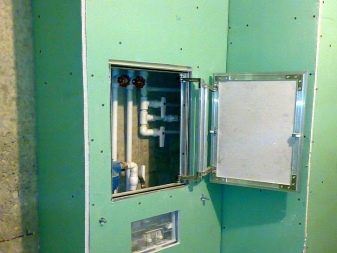
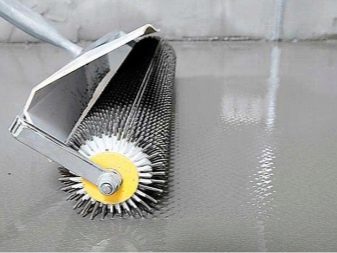
When the floor is ready, it is the turn to work with the walls. They must be primed under the tile; for pronounced irregularities, a cement putty is applied. Plasterboard boxes do not finish under the tiles, with the exception of double priming and sealing each seam. A rail or levels are mounted along the entire perimeter at the height of the first tile. This will allow you to finish the room as accurately and quickly as possible.
The masonry goes in rows until the desired height is reached; placing crosses relies on the joints both vertically and horizontally. When the day has passed, the rail is removed and the lower tiles are laid. If those do not fit, you can trim problematic elements. So, without unnecessary difficulties, decorating the walls with your own hands is no worse than with the help of a team of finishers. Grouting is done in a standard way.


The situation is different when using plastic panels. A frame is formed along the walls from metal or wooden profiles. The gap from one column to another is a maximum of 50 cm. The frame must run at right angles to the movement of the panels. It is not difficult to put the blocks themselves: you need to put the first part into the starting profiles or corners; attach all structures with self-tapping screws through the extreme protrusions.

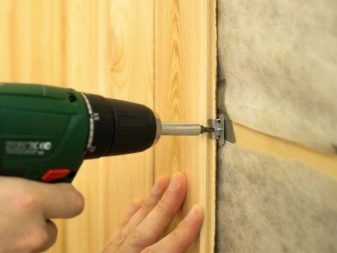
Then the corners will need to be closed with special elements: they are either fixed before the panels, or glued on the outside on liquid nails. If wallpaper is selected, the entire surface is cleaned of dirt and dust particles, and it is thoroughly primed. Then the walls are plastered using "Vetonit" for wet rooms. Applying it once or twice depends on how much the walls are deformed. In especially difficult situations, they are impregnated with a primer even three times.
Surfaces dried after priming are leveled with a float and emery paper. You need to move them in a circle. If residual defects are found, they are additionally putty and rubbed. After cleaning the walls from dust, they need to be primed again. That's all, this completes the preparation for pasting the wallpaper.
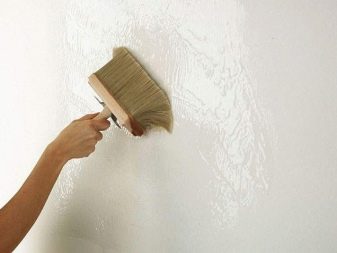
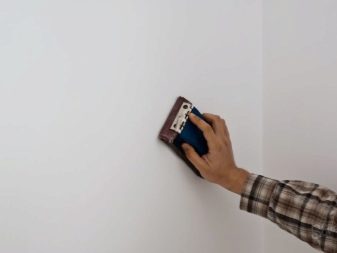
Having overcome all the difficulties in decorating the walls, they take up the ceiling. If it is hinged, you need to draw a line along the perimeter with a level to expose the structure. The guide profiles are attached to the walls, for this purpose you will need holes for quick fixing dowels. The step between the main profiles is 0.4 m, the line of their passage serves for attaching suspensions. Having prepared the frame, you need to attach a selected material to it (necessarily combined with wall decoration by color).
The next step is the placement of plumbing and other equipment. Important: installations for suspended toilets should be done prior to wall cladding. In the case of traditional plumbing, the corrugation is attached to the sewer inlet pipes and connected to the toilet. Then it is put in the required position, since the flexible hose is easy to move as you like. The tank should not rest against the wall, even at a single point.
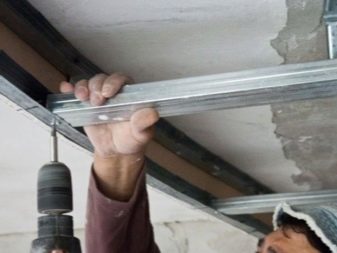
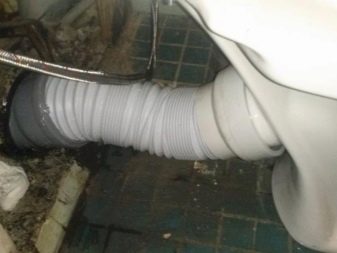
The marking of the toilet bowl sole on the floor is done together with the drilling point. At this point, drill bits are used for concrete, and they go through the tiles with a special drill for ceramics. Dowels are placed in the drilled holes, then the toilet is exposed and pressed against the base on the hex screws. For your information: rubber washers should be placed under the screws, they will prevent delicate plumbing from breaking. The hats of the fasteners are covered with decorative plugs.
Only after all these works does it become possible to connect the water and seal the joint of the toilet bowl with a silicone-based compound. If a sink is also placed in the toilet, the choice is reduced to fixing it on the brackets from the kit or on the dowels screwed into the wall. Usually they are guided by the directions of the instructions. Only after fastening can the water supply and drainage channel be connected. But the overhaul of the toilet does not stop there either.
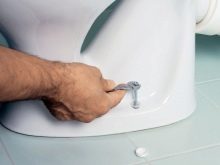
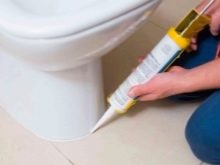

How to finish?
Next, proceed to the installation of doors. The position of the box is verified as accurately as possible from all sides. When using a heavy canvas, the box is screwed with dowels. You should not be afraid of their poor appearance - you just need to position the fasteners in the area of the hinges and below the latch groove. For your information: experienced craftsmen check the level after each manipulation in order to avoid the slightest shift. When the installation of the canvas is finished, you need to apply polyurethane foam, filling the entire gap around the perimeter.
When removing the foam from the cylinder, they move it in a zigzag fashion, trying to keep the box in a certain position. Do not put in excess foam, because it will inevitably expand and go beyond the contour. Cut off the foam from the outside after ½ day, while you need to be careful and leave everything inside. Excessively thin boxes are complemented by additional details. If there are grooves, you need to cut the strips to the required size and snap into place; simple boards are planted on foam or fixed with self-tapping screws.
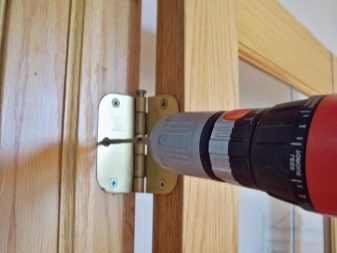
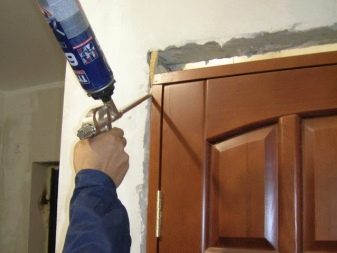
No matter how diligently the doors themselves are mounted, if their choice was unsuccessful, the problems will grow like a snowball. Glass structures, in whole or in part, look elegant and become a winning design element. Do not be afraid of peeping from the outside, because you can order a version with darkened or frosted glass. If there are small children, elderly people or seriously ill people in the house, such doors to the bathroom will allow you to control the silhouette through the glass and come to the rescue in time. At the same time, glass doors are environmentally friendly and convenient, they well dampen extraneous noise. There are many interesting models in the assortment of any manufacturer.
In terms of hygiene and convenience, PVC doors are no worse than glass doors, moreover, they are usually lighter than wooden ones.This allows you to refuse from powerful hinges and heavy boxes, from strengthening the walls. Even with minimal maintenance, the special film will last for many years.
It is possible to mount wooden doors only if the bathroom is equipped with strong exhaust ventilation. If it is not there, then even the most moisture-resistant rocks will damp and deteriorate in a short time.

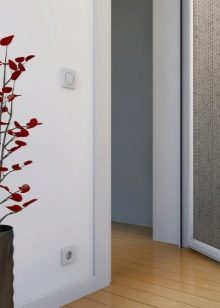
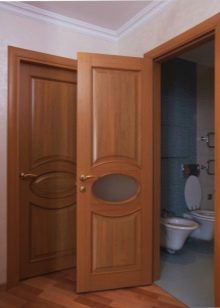
Successful examples
You can take a long time to figure out exactly how it is better to arrange a toilet in an apartment or house, consult with experts and friends. But it is most likely to have before your eyes the most interesting samples and ideas that you can focus on.
Then it will turn out to transform an ordinary toilet into a truly unusual and original space.
- This is how you can make a fairly large toilet room with an area of 10-12 square meters. m. Near the door there is a sink, and a toilet bowl is fixed in the center of the wall opposite to the entrance. The squares of rich red tiles seem to form a continuous strip connecting stylistically the floor and the wall. An exquisite dark door with a vertical window on the left completes and completes the composition.
- The modern approach to the design of toilets can be different, but therefore no less original. The familiar "white throne" is the only item of this color chosen by the designers. The walls and floor are decorated with natural stone of different colors. Almost everywhere it is smooth and even, but on the left above the cupboard with cupboards, the wall is made with a pronounced relief. And in the part farthest from the entrance, the stone background is suddenly replaced by a gorgeous green panel, reflected by an oval mirror suspended on another wall.
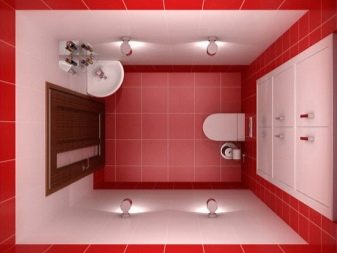
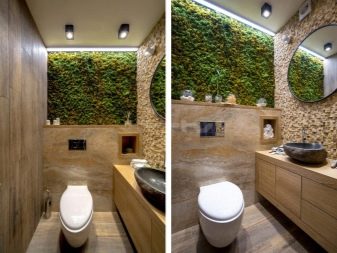
- And this composition clearly contains references to the plots of computer games twenty years ago. An abstract figure in the form of yellow raster cells on an impeccably black wall seems to hint at this. Looking a little lower, you can see a painted gray wheel, and to the right of it - a flower and cologne, standing on a stand. The picture on the cistern is funny and even kind of childish in spirit. A wooden door made of slightly brown planks, a brick wall going at an angle, plus an emphasized antique lighting solution, make the design quite original.
- Here, all the design is created on the play of white and red colors. On the side walls, they are present in their pure form, and the wall farthest from the entrance is made in Scottish motives. The floor is painted in the same way.
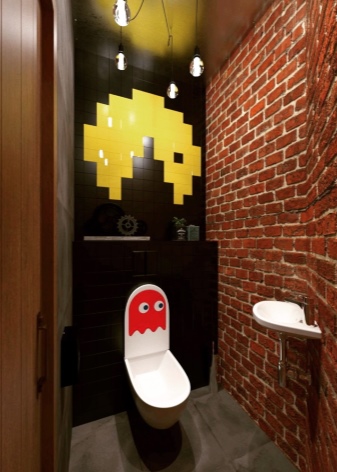

- Similar paints have been chosen here, but you can immediately see how different designers have worked on the project. It seems to be a small detail - a sparkling metal plate that allows you to make a very powerful accent. A suspended wall-mounted sink looks timidly out of a niche.
- It is not necessary to combine white and red tones, combinations with blue look good too. Squares on the floor and rectangles on the walls make for a pretty eye-catching look. The toilet and sink are positioned in such a way as to save space as much as possible. One of the walls is decorated with a blue floral pattern against a calm white background. Numerous spotlights, guessed by the reflections, provide a comfortable environment for people.
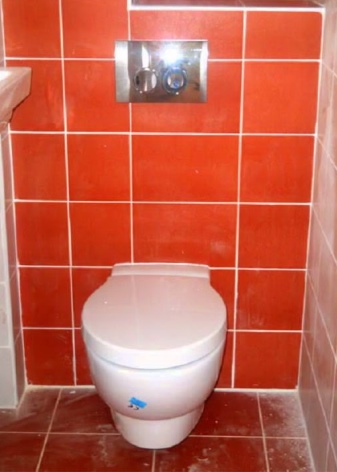
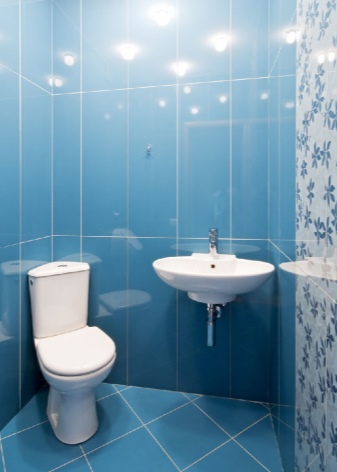
You will learn even more tips for toilet renovation in the following video.













The comment was sent successfully.